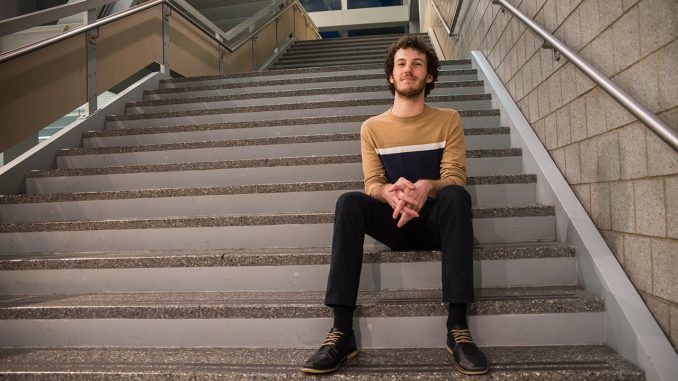

Until 2013, the American Psychiatric Association’s Diagnostic and Statistical Manual of Mental Disorders defined anorexia nervosa as a women’s disease.
Diagnostic criteria for anorexia, which is still characterized as a restriction of energy intake and refusal to gain weight despite being underweight, included “amenorrhea,” or the loss of three consecutive menstrual cycles, in the DSM-IV-TR. This was removed from the definition in the DSM-V.
In actuality, anorexia, which has the highest mortality rate of any mental illness, according to the National Association of Anorexia Nervosa and Associated Disorders, affects people of all genders. Factors like the previous DSM criteria, long-standing gender stereotypes, and female-only treatment centers, serve to reinforce the idea that only women suffer from anorexia and deter people of other genders from seeking help.
Jacob Kurtz, a senior community development major, struggled with anorexia in middle school when he discovered he identified as gay.
The perceived normalcy of over-exercising in males, combined with the lack of visibility from male role models in the body positivity movement discouraged him and others from talking about his disorder, Kurtz said.
“Even though I did have [an eating disorder] and it still impacts me today… I feel like it’s almost not my space to talk about it,” Kurtz said.
Widely known treatment centers like The Renfrew Center, which has a residential facility in Philadelphia, admits women and transgendered people to their programs, but not men.
“When we opened in 1985, we were quite connected to the feminist movement,” said Dr. Samantha DeCaro, an assistant clinical director at The Renfrew Center of Philadelphia. “Women are at greater risk of developing an eating disorder [and] there was a need for women to have a safe place to recover from their eating disorders without just being refed.”
In the last couple years, the program expanded its intake to include transgender women and nonbinary individuals, DeCaro said.
“There is a need for the LGBTQ community to have treatment and have good treatment,” DeCaro said. “We realized that we needed to make it clear that we were able to, that we were welcoming to them as well.”
Ilana Sawyer, 27, came out as transgender while in recovery at The Renfrew Center of Northern New Jersey in Summer 2017. Though recognizing their gender identity helped Sawyer move forward in their recovery from anorexia and bulimia, they did not feel comfortable discussing this in treatment.
“Needless to say, I did not explain my gender awakening in therapy at Renfrew,” Sawyer said.
State licensure and gendered stigma may also contribute to these regulations and the stereotype that eating disorders are for women.
“When eating disorder treatment first started, it was definitely seen as more of a female issue than it was male,” said Tamie Gangloff, the regional outreach manager for the Monte Nido Eating Disorder Center of Philadelphia. “Sure, there’s definitely a higher incidence of eating disorders in females. However, we see it in all genders.”
Monte Nido offers treatment centers nationwide and recently opened a gender-inclusive residential in Long Island, New York and will be opening one in Maryland later this year, Gangloff said. Their older residential facilities are not.
“We had gone back to see if we could try to change some of that licensure, but that’s a challenge,” Gangloff said. “Moving forward with our newer facilities, we are able to do that.”
During their own recovery, Sawyer’s father died from anorexia in January 2019 while being treated in a Philadelphia hospital. His gender was a barrier that stopped him from getting sufficient help, they said. Their father who died was their biological father’s husband, who took on the role of Sawyer’s “second dad” when they were 7-years-old.
“The gay community has a problem with body image, especially in men,” Sawyer said. “I don’t think he really knew how to ask for help or where to ask until it became too late.”
“There’s definitely a higher percentage of gay males that have eating disorders,” Gangloff said. “There’s different societal pressures to be thinner, be a certain size and look a certain way.”
Among males who have eating disorders, 42 percent are gay, according to the National Eating Disorders Association.
Looking back, Kurtz saw this problem.
“If you’re a kid and you look up ‘gay,’ you see the stereotypical gay man that’s a white, toned guy,” he added. “So I’m looking at that… and I’m looking at myself in the mirror. I’m not that. So how do I get there?”
Statistics about the number of men and transgender individuals struggling with eating disorders are likely under reported, Gangloff said. There is not one type of eating disorder patient and there is not one type of eating disorder.
“One of the struggles is getting [a man’s or transgender’s] family to see that this is a serious eating disorder,” Gangloff said. “I think it doesn’t get notice until it’s very severe for that reason.”
“Once more treatment centers are able to treat all genders, it will take some of that stigma away,” Gangloff added.



Be the first to comment